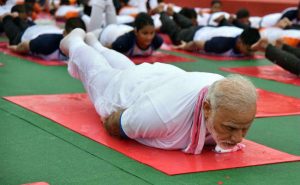 Amlendu Bhushan Khan / NEW DELHI
Amlendu Bhushan Khan / NEW DELHI
At the time Prime Minister Narendra Modi was highlighting the important points of his government budget (2018-19), bad news was coming from Rajasthan and West Bengal where Bhartiya Janata Party losing the byelections in both states.Now it has to be seen this budget, how this budget will help Prime Minister Narendra Modi in the forth coming general elections.
Modi is going to face the Lok Sabha election in 2019 and this budget is the last budget of his government. So the government provide the health insurance for 50 crore people of the country. But, it is expected that the scheme will face so many hurdles in the implementations.
The scheme, which the government dubs “Modicare”, was announced in Thursday’s general budget for 2018/19 and would provide 100 million families, or about 500 million poor people, with health cover of 500,000 rupees per year for free treatment of serious ailments.
Several states now offer health insurance but these schemes are generally small and poorly implemented. Modi faces a national election next year and the new health program is seen as a signature initiative to woo voters in the countryside, many of whom struggle with high healthcare costs.
Prime Minister Narendra Modi’s plan to provide health insurance for about half the country’s population would require an estimated 110 billion rupees ($1.7 billion) each year, sources said.
The government estimates the cost of insuring each family under the new scheme at about 1,100 rupees ($17.15), said a government official who had direct knowledge of the matter and did not want to be identified.
Officials have said “the world’s largest government funded health care program” would have a federal allocation of 20 billion rupees in 2018-19, but added that more funds would be made available as the program is rolled out over the year.
Some critics have raised doubts whether 2000 crores rupees funding is enough to support the program for 2018-19.
However, the government official said of the 110 billion rupees in premiums required to fund the program, the federal government would contribute about 70 billion rupees with the 29 states providing the rest.
The 50 billion rupees in federal funding on top of the budget allocation of 20 billion rupees would be made available as the scheme details are worked out over the coming months, the official said.
“Government health insurance companies have readily agreed to fund the program (at this cost),” the official said.
A second source familiar with the planning said the government could also partly use the funds raised from a newly imposed 1 percent health cess on taxable incomes, and the health scheme would also benefit from the planned merger of three state-run insurance firms announced in Thursday’s budget.
“It’s a big pool (of people), when you have a mammoth insurance company, the task becomes easier,” said the source, adding that the government’s premium payments for the scheme were expected to be low and manageable.
Modi’s government on Thursday also raised the federal health budget by 11.5 percent to $8.3 billion for 2018-19.
The measures are Modi’s latest attempt to reform a public health system that faces a shortage of hospitals and doctors. The government has also in recent years capped prices of critical drugs and medical devices and increased health funding.
Still, India spends only about 1 percent of its GDP on public health, among the world’s lowest, and the health ministry estimates such funding leads to “catastrophic” expenses that push 7 percent of the population into poverty each year.
A top official at a state-run insurance company said the government will take 4 to 6 months to finalize the contours of the health plan since it would take time to get hospitals on board.
Nevertheless, a government-sponsored health program will come as a major boost for the private hospital sector in India. Overburdened public hospitals mean nearly 70 percent of healthcare delivery is in the hands of private players.

















